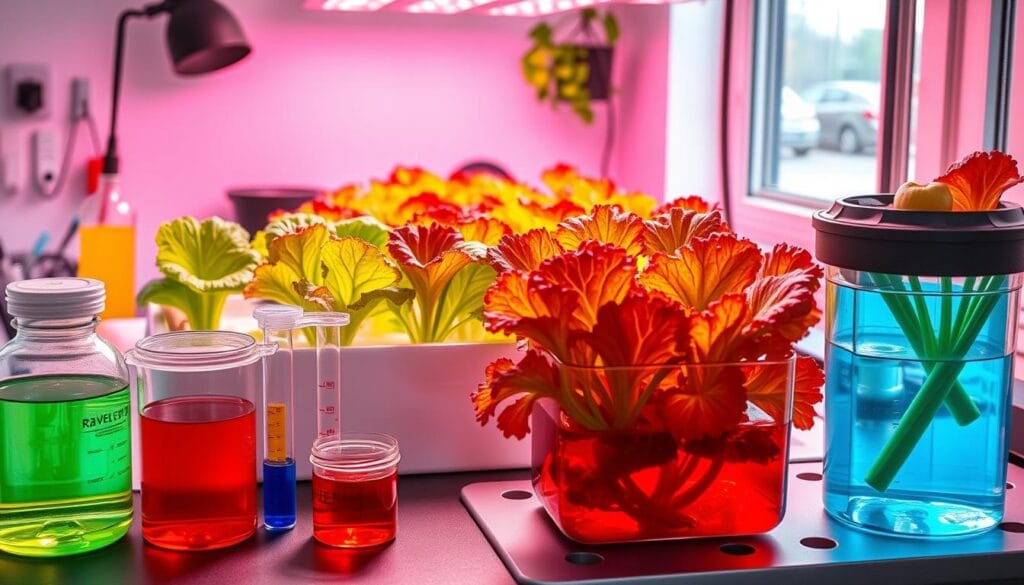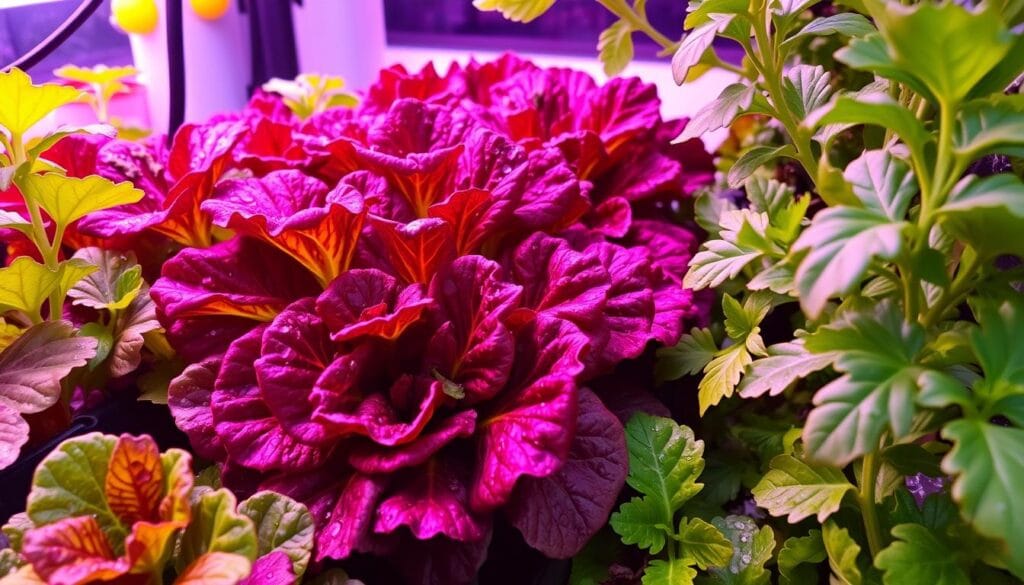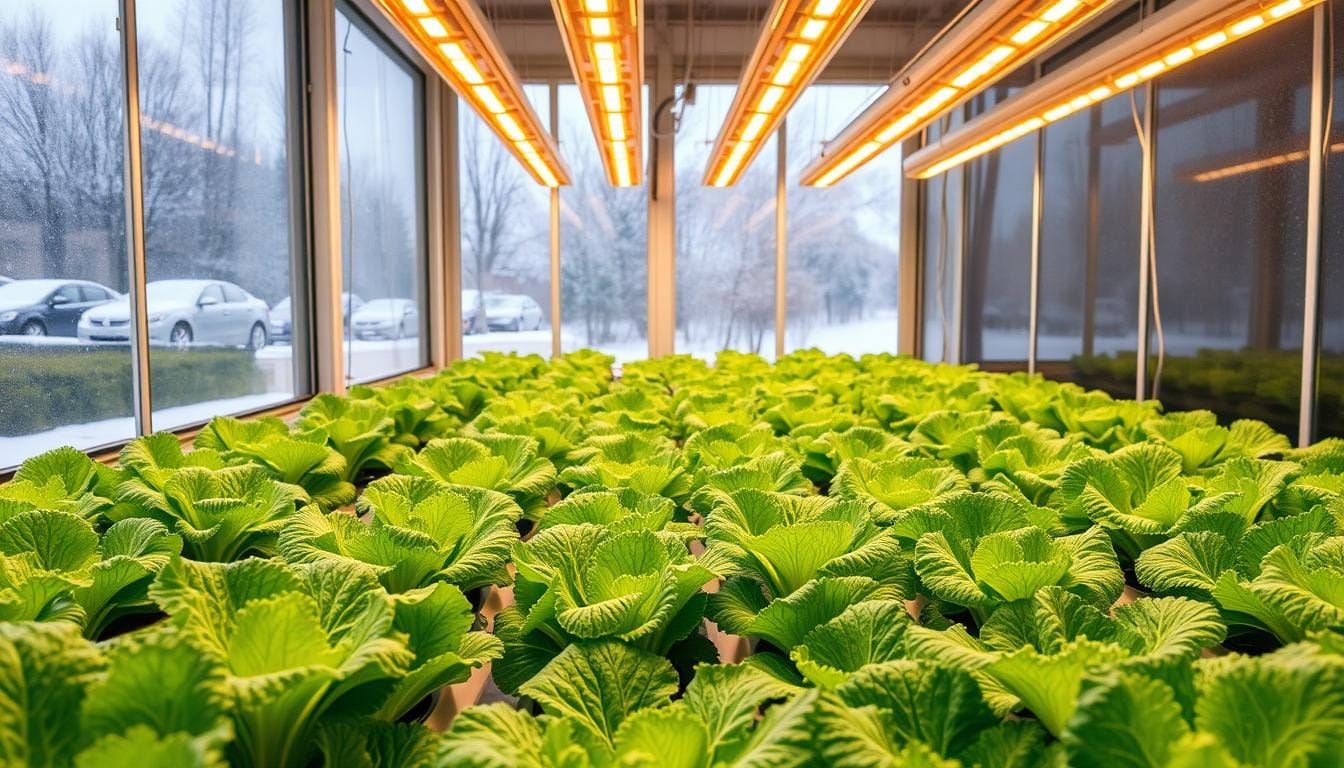How to grow Rafael lettuce in hydroponics during winter is simpler than you might think. Winter gardening doesn’t mean you have to stop growing. Hydroponic lettuce cultivation is a game-changer, allowing you to grow fresh and crisp lettuce indoors all year round, even during the colder months.
Indoor hydroponic gardening is my favorite, even in winter. Rafael lettuce is a standout crop. It grows well indoors, giving you fresh greens all winter.
Imagine picking fresh lettuce in just weeks. You’ll use up to 90% less water than traditional farming. This guide will show you how to create a top-notch winter hydroponic lettuce system. It will give you great yields and quality greens.
Key Takeaways
- Learn advanced hydroponic lettuce cultivation techniques
- Discover space-efficient indoor growing strategies
- Understand precise environmental control methods
- Maximize crop yield during winter months
- Reduce water consumption through smart hydroponic systems
Introduction to Winter Hydroponic Lettuce Cultivation
Winter can be tough for farming, but hydroponics offer a new way to grow Rafael lettuce indoors. This method is perfect for cold months when outdoor farming is hard.
Hydroponics grow lettuce without soil, using water full of nutrients. It has many benefits:
- Year-round crop production
- Reduced water consumption
- Minimal pest and disease risks
- Higher crop yield per square foot
*”Controlled environment agriculture transforms winter growing from a challenge into an opportunity.”*
Mexico shows how well these new farming ways work. In 2023, they produced 523,000 tons of lettuce. Guanajuato stands out as the leading producer, accounting for an impressive 28% of the total lettuce output.
| Region | Production Percentage |
|---|---|
| Guanajuato | 28% |
| Zacatecas | 17.8% |
| Aguascalientes | 14.8% |
Learning about indoor farming and hydroponics helps grow Rafael lettuce in winter. The trick is to create a stable, nutrient-rich space perfect for growing.
Understanding Rafael Lettuce’s Characteristics
Rafael lettuce is a standout in leafy greens. It’s part of the lettuce family and is great for growing in hydroponics.
Nutritional Profile
Rafael lettuce is packed with nutrients. It has minerals that are good for your health.
- Calcium levels ranging from 0.9 to 2.9%
- Phosphorus content between 0.4 to 1.2%
- Zinc concentrations from 17.5 to 46.2 ppm
Growth Patterns
Knowing how Rafael lettuce grows is key for hydroponic success. These plants grow well in controlled spaces.
“The genetic variation in lettuce allows for impressive heat tolerance and resilient growth characteristics.”
Optimal Growing Conditions
| Environmental Parameter | Recommended Range |
|---|---|
| Daytime Temperature | 21-27°C (70-80°F) |
| Nighttime Temperature | 18-20°C (64-68°F) |
| Humidity | 60-70% |
| Daily Light Exposure | 14-16 hours |
| Light Intensity | 500-700 μmol/m²/s |
To care for Rafael lettuce, keep the environment steady. Proper airflow not only promotes healthy growth but also helps prevent diseases. With the right hydroponic care, you can get the best results.
Essential Hydroponic Equipment Setup
Setting up the right hydroponic system is key for growing Rafael lettuce in winter. Your equipment affects the quality and amount of your crop. Professional growers use precise tools to control plant growth.
Key hydroponic equipment for growing Rafael lettuce includes:
- pH Meters: Critical for maintaining nutrient solution acidity between 5.5-6.5
- Electrical Conductivity (EC) Meters: Tracks nutrient concentration
- Digital Thermometers: Monitor temperature precisely
- Grow Lights: Provide essential light spectrum for vigorous growth
- Climate Control Systems: Regulate temperature and humidity
Your grow lights are vital for winter lettuce growth. Full-spectrum LED grow lights can provide 14-16 hours of bright light daily, with an intensity of 500-700 µmol/m²/s. These lights ensure your lettuce gets enough light in winter.
“Precision in equipment translates directly to success in hydroponic lettuce cultivation” – Hydroponic Experts Network.
Climate control systems are also key. They keep the growing area at the right temperature and humidity. Daytime temperatures should be 21-27°C, and nighttime around 18-20°C. Humidity should be 60-70% to avoid fungal problems.
By choosing high-quality hydroponic equipment, you’ll create a perfect environment for your Rafael lettuce. This is true even in the tough winter months.
How to grow Rafael lettuce in hydroponics during winter
Winter hydroponic techniques need careful control of temperature, light, and humidity. This is key to increasing Rafael lettuce indoors successfully.
Growing indoor lettuce in winter has its own set of challenges. To overcome these, create a microclimate that matches the lettuce’s ideal growing conditions.
Temperature Control Methods
Keeping the right temperature is vital for growing leafy greens in winter hydroponics. Here are some important steps:
- Maintain daytime temperatures between 70-80°F (21-27°C)
- Keep nighttime temperatures around 64-68°F (18-20°C)
- Use digital thermometers for precise monitoring
- Install heating mats under growing trays
- Utilize insulated grow rooms or dedicated greenhouse spaces
Light Management Strategies
Winter needs extra light because of less natural daylight. Here’s how to manage lighting:
- Provide 14-16 hours of full-spectrum grow lights daily
- Position LED lights 6-12 inches above the plant canopy
- Use automatic timers for consistent light exposure
- Select lights with blue and red spectrum for optimal growth
Humidity Regulation
Keeping humidity balanced prevents plant stress and disease. Aim for 60-70% humidity using these methods:
- Install small fans for air circulation
- Use humidity trays beneath growing containers
- Monitor humidity with digital hygrometers
- Avoid overcrowding plants to prevent moisture buildup
“Precise environmental control transforms winter hydroponic lettuce growing from challenging to consistently successful.” – Hydroponic Experts Network.
By using these winter hydroponic techniques, you’ll create the perfect environment for Rafael lettuce. This ensures strong growth and high-quality yields all winter long.
Choosing the Right Hydroponic System
Choosing the right hydroponic system for growing Rafael lettuce in winter is key. You need to pick a system that fits your growing conditions and resources.
When growing winter lettuce, picking the right system is important. NFT systems, deep water culture, and ebb and flow hydroponics are great for cold seasons. Each has its benefits for growing Rafael lettuce.
- Nutrient Film Technique (NFT) systems:
- Excellent for precise nutrient delivery
- Minimal water usage
- Requires consistent temperature management
- Deep water culture (DWC) systems:
- Provides continuous nutrient access
- Supports rapid plant growth
- Needs uninterrupted power supply
- Ebb and flow hydroponics:
- Versatile growing approach
- Flexible irrigation cycles
- Dependent on electrical timers
“The right hydroponic system can make all the difference, turning winter lettuce growing into a seamless and rewarding experience.” – Hydroponic Experts Collective.
Your choice affects plant health, yield, and how well you use resources. Think about your space, budget, and skills when picking a hydroponic system for Rafael lettuce.
| System Type | Winter Performance | Nutrient Efficiency | Complexity |
|---|---|---|---|
| NFT Systems | Good | High | Moderate |
| Deep Water Culture | Excellent | Very High | Low |
| Ebb and Flow | Good | Moderate | High |
Try out different systems to find the best one for growing Rafael lettuce in winter.
Nutrient Solution Preparation and Management
Successful hydroponic lettuce cultivation depends on precise nutrient solution management. Your Rafael lettuce’s growth relies on balanced hydroponic nutrient solutions. These solutions provide essential elements for optimal development.

Essential Nutrients for Rafael Lettuce
Rafael lettuce needs a strategic approach to nutrient delivery. Key nutrients include:
- Nitrogen: Critical for leaf growth
- Potassium: Supports overall plant health
- Calcium: Strengthens cell walls
- Magnesium: Crucial for chlorophyll production
pH Balance Guidelines
Maintaining proper pH balance is key for nutrient absorption. Your hydroponic system should keep pH levels between 5.5 and 6.5. This range ensures maximum nutrient availability and prevents nutrient lockout.
“Precision in pH management is the key to thriving hydroponic Rafael lettuce” – Hydroponic Experts.
Electrical Conductivity Monitoring
Electrical conductivity (EC) monitoring helps track nutrient concentration. Aim for EC levels between 1.5 and 2.5 mS/cm to support robust lettuce growth.
| Growth Stage | Nutrient Concentration (ppm) | EC Range (mS/cm) |
|---|---|---|
| Seedling | 50-70 | 1.2-1.5 |
| Vegetative | 100-150 | 1.5-2.0 |
| Mature | 150-200 | 2.0-2.5 |
By carefully managing your hydroponic nutrient solutions, you’ll create an ideal environment for Rafael lettuce to thrive during winter months.
Seedling Care and Transplanting Techniques
Growing Rafael lettuce in hydroponics needs careful attention. Start by choosing the right way to start seeds. Then, learn how to transplant them well in a controlled space.
Begin with rockwool for germinating seeds. These cubes hold moisture well and help roots grow. Keep the temperature between 70-85°F (21-29°C) for strong growth.
“The key to successful hydroponic lettuce is mastering the early stages of seedling development.” – Hydroponic Growing Expert
Here are the key steps for transplanting:
- Select rockwool cubes with uniform moisture
- Wait until seedlings develop 2-3 true leaves
- Carefully remove seedlings from germination tray
- Position roots strategically in a hydroponic system
- Use vertical supports to maintain plant structure
It’s important to place roots right for nutrient uptake. Give your seedlings enough room and support in the hydroponic setup. Vertical trellises or cage supports can help maintain plant structure and improve airflow, reducing disease risk and promoting growth.
By using these seedling care methods, you’ll be on your way to a great Rafael lettuce harvest. This is true even in tough winter months.
Winter-Specific Environmental Controls
Managing your hydroponic lettuce in winter needs careful planning. You must protect your crops from harsh weather. A stable, controlled environment is key to success.
Keeping your hydroponic system safe in winter involves several important steps. These steps help keep your plants healthy and productive.
Hydroponic Insulation Techniques
Insulation is vital for keeping your greenhouse warm. Here are some effective insulation methods:
- Install double-layer plastic sheeting on greenhouse walls
- Use bubble wrap for extra warmth
- Seal any air leaks
- Create wind barriers around the greenhouse
Heat Management Strategies
Controlling heat is essential for winter greenhouse management. Use these methods to keep the temperature right:
- Use water barrels as thermal mass
- Install radiant heating systems
- Set up automated temperature monitors
Supplemental Lighting Solutions
Winter’s short days mean you need extra light for your lettuce. They need 14-16 hours of good light each day.
| Lighting Type | Efficiency | Power Consumption |
|---|---|---|
| LED Grow Lights | High | Low |
| High-Pressure Sodium | Medium | High |
| Ceramic Metal Halide | High | Medium |
“Effective environmental controls can turn winter from a difficult growing season into a highly productive harvest period.” – Hydroponic Expert.
With these winter environmental controls, you’ll create the best growing space for your hydroponic lettuce. This ensures they grow well, even in tough winter weather.
Disease Prevention and Plant Health
To keep hydroponic plants healthy, you need a solid plan for disease control. Growers of Rafael lettuce must use smart strategies to guard their crops. This includes fighting off harmful microbes and dealing with environmental issues.

- Regular monitoring of plant conditions
- Implementing UV-C decontamination systems
- Maintaining strict hygiene protocols
- Proactive nutrient solution management
UV-C decontamination is a modern way to fight diseases in hydroponics. It kills bad microbes but keeps plants healthy. Studies show it can make plants grow faster and lower disease risks.
“Preventive measures are far more effective than treatment in hydroponic systems, as highlighted by the Agricultural Research Institute.”
To stop diseases, you must know what can harm your plants. Focus on:
- Spotting early signs of plant stress
- Keeping the environment just right
- Doing regular clean-ups
- Using top-notch nutrient solutions
Using the latest disease control methods helps create a strong hydroponic system. This system supports the healthy growth of Rafael lettuce, even in winter.
Harvesting and Storage Methods
Mastering the hydroponic lettuce harvest needs precision and careful attention. When your Rafael lettuce reaches about 17 cm, it’s time to use expert post-harvest handling. This helps keep its quality and nutritional value high.
Here are the key steps for your hydroponic lettuce harvest:
- Use clean, sharp scissors or harvesting knives
- Cut lettuce leaves at the base, leaving the root system intact
- Handle leaves gently to prevent bruising
- Remove any damaged or discolored leaves immediately
Keeping lettuce fresh is key. After harvesting, cool your lettuce quickly. Store it at 35-40°F (2-4°C) with humidity around 95%.
“The key to exceptional hydroponic lettuce is not just in growing, but in careful post-harvest handling.” – Hydroponic Farming Expert
Here’s how to store your lettuce:
- Immediate cooling after harvest
- Using perforated storage containers
- Maintaining consistent refrigeration
- Minimizing exposure to direct light
By using these professional hydroponic lettuce harvest and storage methods, your crops will stay crisp, nutritious, and ready for market for a longer time.
Troubleshooting Common Winter Growing Issues
Winter hydroponic growing has its own set of challenges for Rafael lettuce growers. To solve these problems, it’s important to manage the environment and plant health well. Knowing how to quickly fix issues can help your crop thrive or fail.
Temperature Fluctuations
Unpredictable temperature changes are a big problem in winter. Your hydroponic setup needs constant watching to keep the right growing conditions. Rafael lettuce grows best at 22-24°C. Here are ways to handle temperature:
- Install reliable heating systems
- Use insulation materials around growing areas
- Implement temperature sensors for real-time monitoring
- Create buffer zones to minimize sudden temperature changes
Light Deficiency Solutions
Insufficient light can cause nutrient problems in plants. In winter, artificial light is key for Rafael lettuce. Try to give them 14-16 hours of bright light each day to make up for less natural light.
- Use full-spectrum LED grow lights
- Position lights to ensure uniform coverage
- Implement light timers for consistent exposure
- Monitor light intensity using specialized meters
Nutrient Imbalances
Keeping the nutrient solution right is vital for healthy hydroponic Rafael lettuce. Regular checks and tweaks can stop nutrient issues. Here are some tips:
- Check pH levels between 5.5 and 6.5
- Monitor electrical conductivity (EC) between 1.5-2.5 mS/cm
- Change nutrient solutions every 10-14 days
- Adjust nutrient concentrations based on the growth stage
“Successful hydroponic cultivation is about precision and consistent monitoring.” – Hydroponic Growing Expert.
Conclusion
Hydroponic lettuce in winter is a new way to farm that’s good for the planet. It uses special controls to save water and grow crops faster. You can save up to 90% of water and harvest 15-20 days quicker than soil farming.
There are many benefits to growing hydroponic lettuce. You can regulate temperature, humidity, and nutrient levels. This makes your crops grow better and stay healthy. You can even grow up to 4-5 lbs of lettuce per square foot, even in cold winter months.
As the weather changes, hydroponics is a strong choice for farmers and gardeners. Learning these methods helps you grow more than just lettuce. It’s about joining a movement that makes farming better and gives us fresh food all year.

